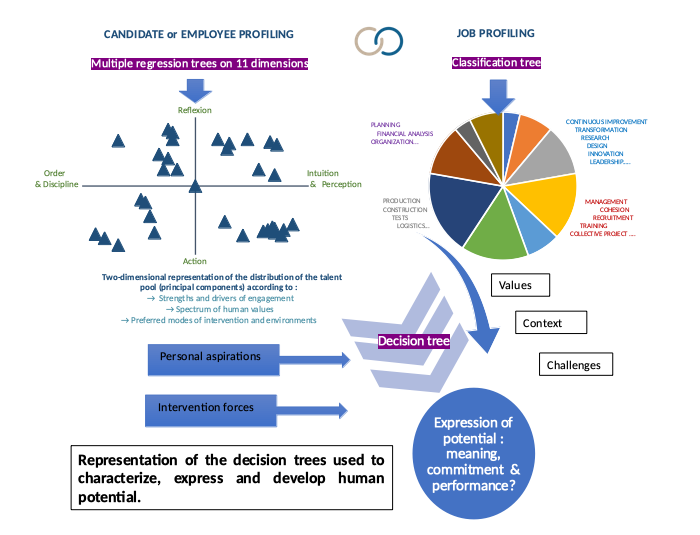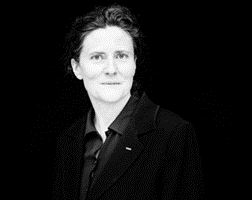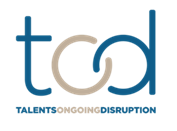We believe in “A world where man uses AI to become more human”: indeed, AI can allow us to no ...
We believe in “A world where man uses AI to become more human”: indeed, AI can allow us to no longer look at, scan, and evaluate the men and women of the company as resources, but to consider them through their human values as real actors, builders and integral parts of the company.
Nowadays, companies are facing a real war for talent and commitment. It isn’t attractive anymore for people: it has trouble recruiting, it has trouble committing its employees over time and retaining the best.
Nearly 30% of executives hired on permanent contracts leave their new employer less than a year later, and the reasons for these failures are always the same: new employee does not find enough meaning in his or her work, he or she is not sufficiently valued or solicited, or he or she feels a misalignment between his or her personal values and the values of the company; all of these considerations remain essentially human, behavioral or managerial and illustrate the difficulty of the company to keep the promises of the candidate experience.
All of these ills originate in the processes themselves, which most of the time consist of putting CVs in job descriptions, or assimilating men and women to jobs and skills that are managed according to reference systems, processes that have been taken over by artificial intelligence without adding the necessary humanity to alleviate their harmful consequences (disengagement, boredom, even suffering).
In a CV, there is no personality or desires section and even less human values section, because these cannot be measured in numbers and are difficult to express with words. And yet it is the values that moderate the candidates, their commitment drivers, their desires, their personality, everything that makes them unique, but which is invisible in a CV, that will make them strong. And it is the sharing of these human values that will make the teams strong.
AI has been used in the field of human resources, initially with excellent intentions, those of freeing HRDs from repetitive tasks with low added value (payroll, time management…) or automating processes to make them more objective and reduce discrimination. But unfortunately, this has led to the dehumanization of processes that were already not particularly human. Candidates or employees no longer find themselves in this hyper-digitalized world of work, which sometimes locks them up for life in boxes, which no longer sees them as men and women but as digitized CVs, skills, “resources” or even “charges”…
It is rather a question of being interested in artificial intelligence as a means of paradoxically bringing a more human look to the men and women of the company and of wondering how to integrate the power of the human into the algorithms to serve the development and the performance of companies.
We are convinced that AI will never replace the essential: human relations and management, the manager’s ability to give a soul to his team, to take it further, faster, higher, but AI can help, especially in highlighting this invisible human potential beyond the skills and experience verbalized in the CVs.
AI can only rely on processes and models that man has designed, it cannot modify them alone. It can learn to enrich them through experience and the growth of its database, but always according to the procedures established by humans. Therefore, if processes are at the origin of the difficulties companies face in HR management, it is not enough to digitalize existing processes or to increase their power thanks to big data: for example, in recruitment, scanning the whole web to find the ideal CV and enriching it with all the personal data that the candidate will have carelessly left lying around on social networks will not bring any major change in the results. It is essential to rethink the HRD in order to meet the company’s challenges.
We are convinced that AI is a great opportunity for HRDs to become the central artisan in building the company of the future.
Here are some very concrete solutions to enable a more human management of human resources:
1- AI to reveal human potential from recruitment throughout the careers paths.
All these impediments would be removed if it were possible to know the values that animate candidates or employees, the aspirations that give meaning to their work, their own driving forces, which make them excited and which need to turn to give their full potential, all these invisible qualities that yet make all their strengths.
By mobilizing the results of neuroscience and psychology to build digital tools, technologies allow us to identify human behaviors more precisely and predict their interactions, to evaluate the human values and drivers of each person. By revealing the true dimension of human capital, these digital tools (AI) aim to become real engagement boosters, catalysts for innovation and business transformation.
More technically, the methods used are based on multiple decision trees, classification and regression on which our explanatory and predictive models are based. The statistical references are derived from work carried out in the field of neuroscience and behavioral psychology since the 1960s, which makes their current use particularly robust. The choice of metrics is based on managerial experience and the biases in the decision-making processes have been removed by a test population of more than 1000 executives.
In most cases, the decision tree is intended to predict how a candidate or employee will perform in a project or position and how they will create value for themselves and the organization given the environment and context. Each node in the tree examines the alignment of a candidate “characteristic” (quantitative or qualitative) with a job expectation or promise. The respective candidate and job “characteristics” are themselves described through classification trees. The characteristics can be continuous variables or of a yes/no form. Without being “random forests” in the mathematical sense of the term, the multiplication of trees seeks to take into account the complexity of human matter.
The principal component analysis of the data taken into account nevertheless allows a simpler illustration. The following diagram shows the main decision trees used in the characterization of human potential.

The recruitment process is no longer a process of evaluation but of highlighting human potential. It is no longer a matter of scanning and evaluating applications or CVs, based on tests or situations that will favor a particular behavioral profile but not necessarily the one expected by the position.
The objective is to reveal human potential, don’t offer companies CVs filled with standardized skills and experience but with aspirations, desires,driving forces, to detect all the human energy that the candidate can bring to enrich the company.
The artificial intelligence integrated into the algorithms identifies and characterizes the strengths and driving forces of the employee or candidate, their human values and analyzes the way they implement them professionally, in order to concretely identify the modes of intervention and professional environments that are most conducive to their development and the exploitation of their skills.
The future employee is not seen as a resource, but as a future integral part of the company, according to the Larousse definition, an “essential constituent element”.
2- AI provides the keys to a better exploitation of human potential throughout the employee experience: successful recruitments, engaged employees, an attractive employer brand.
To succeed in recruitment, it is not enough to offer a rewarding candidate experience by focusing on the candidate’s values and aspirations. From the recruitment phase onwards, it is important to focus on the success of the employee experience, to ensure that the promise of an employee experience is kept and that it responds to the new recruit’s quest for meaning and embodies the values announced.
Indeed, we have created tools based on neuroscience to profile the job to be filled. Once again, the aim is to characterize the ideal profile beyond skills and experience, the one whose personal values will be echoed in the values of the company and the team, the one who will find meaning in the company’s mission, the one who will be valued in his or her activity, because the challenges of the position will call upon his or her most powerful drivers, his or her creativity, pedagogical qualities, his or her ability to generate support, or his or her organizational skills…. All the innovation developed thanks to AI by TOD is based on its ability to position candidates or employees on positions where they will be the most valued, where they will be likely to fulfill their potential.
The objective is to give the company the keys to ensure that throughout his career the employee is always in a position to express his full potential, to always grow through human relations and collective projects of the company.
The potential for creating human value offered by this approach, based on meaning and the search for commitment through the consideration of individual aspirations and operating modes, is almost unlimited: by taking a genuine interest in the driving forces of each individual, and above all in what boosts his or her performance (the managerial context, collective values, team challenges, time horizons, etc.), it is possible to improve collective operations, to establish managerial recommendations aimed at more developing the talents of each employee throughout his or her career. ), it is possible to improve the collective functioning, to establish managerial recommendations intended to develop more the talents of each employee throughout their career.
The company thus ensures the lasting commitment of its employees by integrating the invisible but essential human qualities and values for development and performance.
To conclude,AI allows to take another look at the men and women of the company, at the positions and missions that go beyond the mere adequacy of technical skills to combine and align values, aspirations and challenges in a dynamic way throughout the career path.
In the next few years, AI should allow the real return of man to the heart of the company, whose energy and strength will not be replaced but enhanced by the power of digital.

Gaëlle MONTEILLER, President and co-founder of TOD
TOD offers disruptive solutions across the entire employee experience, from recruitment to mobility and talent management, based on human values for greater meaning, professional fulfillment and personal alignment. https://www.yourtod.com

By Gaëlle Monteiller.
